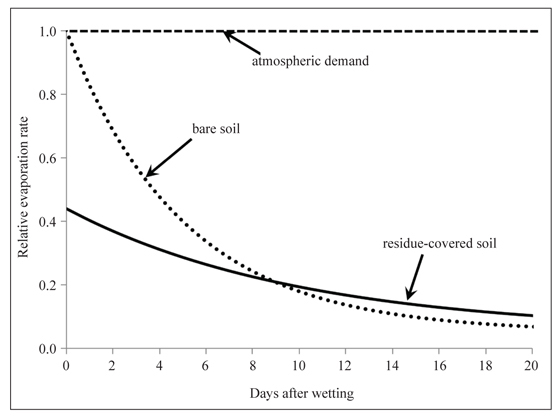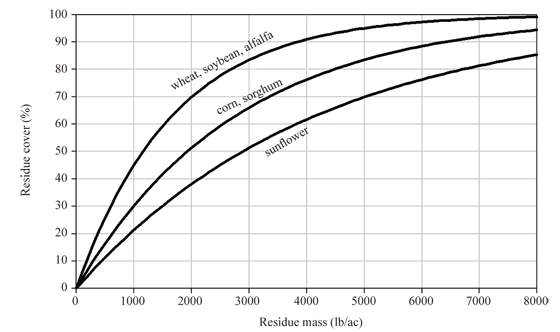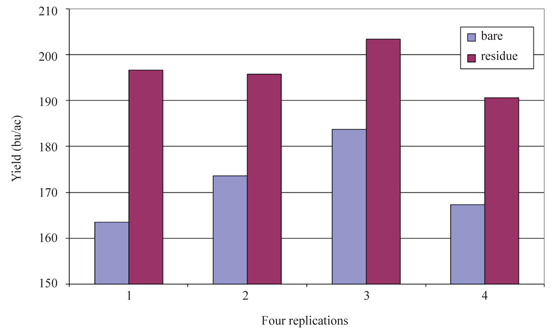G2000
Tillage and Crop Residue Affect Irrigation Requirements
Practicing less tillage and retaining more crop residue on the soil surface can reduce the rate of water evaporation and the amount of irrigation water needed.
Simon J. van Donk, Water Resources Specialist
- Evaporation
- Infiltration and Runoff
- Crop Yield, Residue Mass and Cover
- Effect of Crop Residue on Evaporation, Soil Water Content, and Crop Yield
- Economic Benefits
- Summary
- Resources
Practicing less tillage and retaining more crop residue on the soil surface can reduce the rate of evaporation of water from the soil. These practices also increase the amount of soil water by increasing the amount of water that infiltrates into the soil and decreasing the amount that runs off across the soil surface. Less tillage and more residue coverage can significantly reduce the amount of irrigation water needed to grow a crop.
Evaporation
When the soil surface is wet, evaporation from a bare soil will occur at a rate controlled by atmospheric demand. The evaporation rate decreases as the soil surface dries over time (Figure 1). Water that is deeper in the soil cannot be transported to the surface quickly enough to maintain wet-soil evaporation. The drying surface soil starts to act as a barrier to water transport.
If the soil surface is covered with residue, it is shielded from solar radiation, and air movement just above the soil surface is reduced. This reduces the evaporation rate from a residue-covered surface, compared to a bare soil. Surface moisture under the residue will continue to evaporate slowly. A number of days after the wetting event, the evaporation rate from the covered surface can exceed that of the bare surface (Figure 1).
 |
| Figure 1. Conceptual diagram showing evaporation rates, relative to atmospheric demand, from bare and residue-covered soil after a single wetting event (irrigation or rainfall). |
Eventually, after many days without rain or irrigation, the total evaporation from the bare and residue-covered soil would be the same. In the conceptual diagram of Figure 1, this point has not yet been reached after 20 days. In reality, this point is seldom reached because more frequent wetting events result in more days with higher evaporation rates from bare soil than from residue-covered soil. The net effect over a season is that total evaporation will be greater from a bare soil.
Residue reduces but does not eliminate evaporation, which still takes place from the crop canopy, the residue itself, and the soil every time they are wet. This loss has been estimated to be 0.08 to 0.1 inch for each wetting event. Therefore, light, frequent rains or irrigations are less effective than heavy, infrequent ones. Some center pivot irrigators experience runoff on tilled soils so they apply small amounts frequently, typically only 0.5 inch each time. One-tenth of an inch of evaporation out of 0.5 inch is a 20 percent loss. When adopting continuous no-till, the pivot can apply a greater amount of water before runoff occurs. With more water applied per event, but less often, the evaporation losses are reduced.
Also, tilled soils often dry to the depth of tillage. Each tillage operation can cause 0.5 to 0.75 inch of soil water evaporation. With multiple tillage events, soil water may not be adequate in the seed zone for uniform germination and emergence, resulting in lower yields, even though there may be sufficient soil water the rest of the year.
Infiltration and Runoff
Long-term no-till management leads to better soil structure, less soil crusting, higher infiltration rates, and less surface runoff. Crop residue reduces the energy of water droplets impacting the soil surface and reduces the detachment of fine soil particles that tend to seal the surface. Subsequent soil surface drying can cause further crusting. This sealing and crusting process reduces infiltration and promotes runoff because precipitation or irrigation rates may be greater than the rates at which the soil is able to absorb water. Residue also slows the velocity of runoff water across the soil surface, allowing more time for infiltration.
University of Nebraska–Lincoln (UNL) researchers used a rainfall simulator at Sidney, Neb., to demonstrate differences in infiltration and runoff from no-till wheat stubble and plowed soils. In the experiment, more than 3.75 inches of water was applied in 90 minutes to no-till soils before runoff started, compared with 1.0 inch of water applied in 20 minutes on plowed soil before runoff started.
Standing residue also can conserve water by causing snow to settle, rather than blow to field boundaries, by slowing the wind velocity just above the residue. Subsequent melting snow is more likely to infiltrate because the stubble slows runoff, thus storing more water, which can be used for crop production later in the growing season.
Crop Yield, Residue Mass and Cover
The amount of residue produced at harvest by a crop can be estimated from crop yield. For wheat, yield (bu/ac) is multiplied by 100 to get residue mass in lb/ac. For example, a 60 bu/ac wheat crop is expected to produce approximately 6,000 lb/ac of residue. For corn, yield is multiplied by 50 and for soybean by 60. Thus, a 180 bu/ac corn crop is expected to produce approximately 9,000 lb/ac of residue.
The amount of residue cover is also important to gauge the soil and water conservation benefits of the residue. The relationship of residue mass and residue surface cover is shown in Figure 2. For example, for wheat, 6,000 lb/ac corresponds to a residue cover of almost 100 percent and 1,000 lb/ac of corn residue corresponds to a cover of 30 percent. The thickness of residue also affects conservation benefits and is related to residue mass and residue cover.
 |
| Figure 2. Relationship of residue mass to percent residue cover for various crops (USDA-NRCS National Agronomy Manual, 3rd Edition). |
Effect of Crop Residue on Evaporation, Soil Water Content, and Crop Yield
Research conducted near North Platte, Neb., and Garden City, Kan., by Water Resources Engineer Norman Klocke, showed that soil water evaporation from bare, fine sand and silt loam soils can be as much as 30 percent of evapotranspiration (ET) during the irrigation season of corn and soybean. The studies suggested that evaporation is 15 percent of total ET when wheat straw or no-till corn stover completely cover the soil surface from early June to the end of the growing season. This translates into a 2.5- to 3-inch water savings. Dryland research indicates that wheat stubble can save an additional 2 inches of water during the nongrowing season if the soil profile can retain the water. The water savings in the growing and nongrowing seasons would combine to a total of 5 inches per year. Not all of this can be effective for later crop growth and yield. Assuming that 50 percent of the 5-inch water savings can contribute to crop yield, yield increases may be as much as 10 bu/ac for soybeans and 30 bu/ac for corn.
In 2007, a study was initiated on the effect of crop residue on evaporation, soil water content, and corn yield at the UNL West Central Research and Extension Center in North Platte, Neb. The experiment was conducted on a Cozad silt loam soil with a set of plots planted to corn. There were two treatments: residue-covered soil and bare soil. In April, bare-soil plots were created by using a dethatcher and subsequent hand raking, removing most of the residue. Thus, the overwinter benefits of the residue were the same for both treatments.
The residue-covered plots were left undisturbed. The residue mass on these untreated plots was approximately 3,000 lb/ac, mostly from previous no-till soybean crops. The experiment consisted of eight plots (two treatments times four replications). Each plot was 40 by 40 feet. Winter and spring 2007 were very wet at North Platte and the corn was only irrigated three times with a total of 4.5 inches of water on all plots. The crop was purposely water-stressed so that any water conservation in the residue-covered plots might translate into higher yields.
Differences in soil water content between the residue-covered and the bare-soil plots were small throughout the growing season. However, average corn yield was 197 bu/ac in the residue-covered plots and 172 bu/ac in the bare-soil plots (Figure 3). An additional 2.5 to 3.5 inches of irrigation water on the bare-soil plots would be necessary to produce the same yield as obtained in the residue-covered plots.
 |
| Figure 3. Corn yield on bare soil (avg. 172 bu/ac) and residue-covered soil (avg. 197 bu/ac) in 2007 at North Platte on small field plots. |
This assumes that the yield difference was entirely due to the corn in the bare plots experiencing more water stress. There are good reasons for this assumption. Visually, there were signs that the corn in the bare-soil plots was water-stressed more than the corn in the residue-covered plots: in September the corn on the bare-soil plots turned brown earlier than the corn in the residue-covered plots. It is unlikely the yield difference was caused by lack of nutrients in the bare-soil plots because the corn was fertilized adequately in all plots. Also, it is unlikely differences in compaction caused the difference in yield because all plots had the same history up to the residue removal in April 2007. Compaction differences may be expected in long-term no-till plots compared to long-term tilled plots, but not over this short time frame.
In April 2008, residue was removed from the same four plots as in 2007. As in 2007, all plots were irrigated at the same time with the same amount of water, but the crop was again somewhat water-stressed. The average corn yield in 2008 was 186 bu/ac in the residue-covered plots and 169 bu/ac in the bare-soil plots. It would take an additional 1.5 to 2.5 inches of irrigation water on the bare-soil plots to produce the same yield as obtained in the residue-covered plots. In addition, the residue-covered plots held more water towards the end of the season (1.5 inches more than the bare-soil plots in the top 4 feet). Thus, the combined effect in 2008 is estimated to be a total of 3 to 4 inches of water savings on the residue-covered plots.
Economic Benefits
The economic benefits of the water savings discussed here can be calculated. Less irrigation water needs to be pumped when water is saved with more residue/less tillage. This translates into a savings in pumping cost. An example follows:
- Water savings anticipated from more residue/less tillage: 3 inches on a 130-acre field.
- Pump discharge pressure: 50 psi.
- Performance rating: 80 percent. This is a rating according to the Nebraska Pumping Plant Performance Criteria; 80 percent is an average rating for Nebraska.
- Pumping cost savings is shown in Table I.
| Table I. Pumping cost savings ($) resulting from the above conditions for a dynamic pumping lift ranging between 0 and 400 feet and a cost of diesel fuel ranging between $2.00 and $4.00 per gallon. | |||||
Lift (ft) |
$2.00 |
$2.50 |
$3.00 |
$3.50 |
$4.00 |
0 |
$1,025 |
$1,281 |
$1,538 |
$1,794 |
$2,050 |
50 |
$1,469 |
$1,836 |
$2,203 |
$2,570 |
$2,937 |
100 |
$1,912 |
$2,390 |
$2,868 |
$3,346 |
$3,824 |
150 |
$2,356 |
$2,945 |
$3,534 |
$4,123 |
$4,712 |
200 |
$2,799 |
$3,499 |
$4,199 |
$4,899 |
$5,599 |
250 |
$3,243 |
$4,054 |
$4,865 |
$5,675 |
$6,486 |
300 |
$3,687 |
$4,608 |
$5,530 |
$6,452 |
$7,373 |
350 |
$4,130 |
$5,163 |
$6,195 |
$7,228 |
$8,260 |
400 |
$4,574 |
$5,717 |
$6,861 |
$8,004 |
$9,148 |
For example, for a dynamic pumping lift of 150 feet and diesel at $2.50 per gallon, the pumping cost savings is $2,945. A calculator was developed so you can input your own data and calculate potential savings from irrigating less. It is available at http://water.unl.edu/reduceneed toward the bottom of the page.
In a deficit-irrigation situation there are economic benefits because of higher yields associated with more residue and less tillage. For example, corn yield may be 25 bu/ac higher, as was the case in the 2007 experiment at North Platte, described earlier. For corn at $3/bu, this would be $75/acre and almost $10,000 for a 130-acre field.
Summary
With more residue cover, less solar energy reaches the soil surface and air movement is reduced near the soil surface, resulting in a reduction of evaporation of water from the soil beneath the residue cover. Light, frequent rains or irrigations are less effective than heavy, infrequent ones, because, with every wetting event, evaporation takes place from the crop canopy, the residue, and the soil.
In addition to reducing evaporation, higher residue levels and long-term no-till increase infiltration and reduce runoff, thus directing more water to where the crop can use it. Similarly, in the winter, more standing residue means that more snow stays where it falls, thus storing more water in the soil once the snow melts.
Research at Garden City, Kan., showed that a 5-inch water savings is possible with a cover of wheat straw or no-till corn stover. Earlier UNL research results at North Platte, Neb., largely agree with the findings from Kansas.
Another study was initiated in 2007 at North Platte on the effect of crop residue on evaporation, soil water content, and crop yield. The corn crop on residue-covered and bare-soil plots was purposely water-stressed so that any water conservation in the residue-covered plots might translate into higher yields. In 2007, the average corn yield was 25 bu/ac more in the residue-covered plots compared to the bare-soil plots. It would take approximately 3 more inches of irrigation water on the bare-soil plots to reach the same yield as obtained in the residue-covered plots. Results were similar in 2008.
Water conservation of the magnitudes discussed here will help reduce pumping cost significantly, which can amount to a savings of a few thousand dollars on a typical 130-acre field. But not only irrigators would benefit, because more water would be available for competing needs including those of wildlife, endangered species, municipalities, hydroelectricity plants, and compacts with other states.
Resources
Switching To No-till Can Save Irrigation Water, (EC196-3), at www.ianrpubs.unl.edu/epublic/live/ec196/build/ec196-3.pdf.
Harvesting Crop Residues, (G1846) available at www.ianrpubs.unl.edu/sendIt/g1846.pdf.
This publication discusses issues of crop residue harvest, including nutrient removal and effects on erosion, soil quality, water loss, and yield.
This publication has been peer reviewed.
Visit the University of Nebraska–Lincoln Extension Publications Web site for more publications.
Index: Irrigation Engineering
Irrigation Operations & Management
Issued February 2010